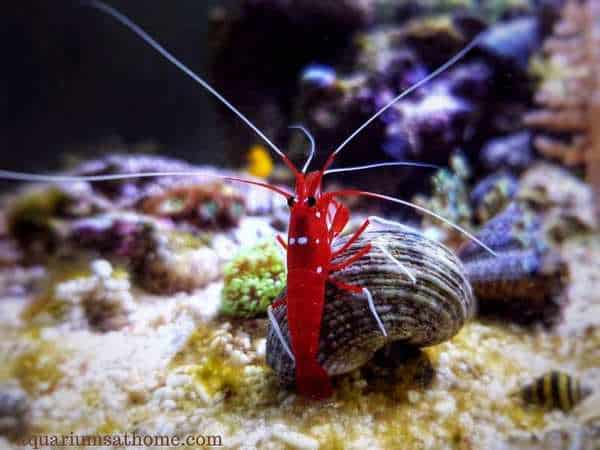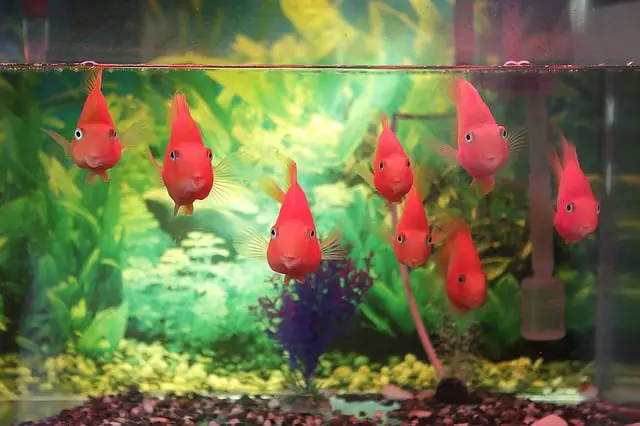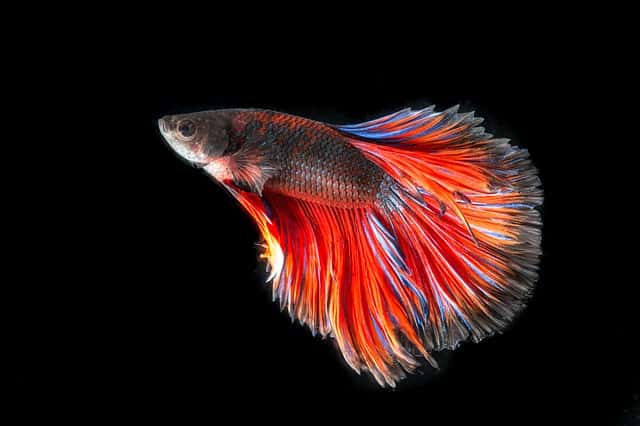Maintaining a clean fish tank is not only important for esthetic reasons but to ensure a safe environment for all aquatic creatures. If you’re an experienced hobbyist, you know first-hand that proper aquarium maintenance is no easy task – it takes both time and resources to do it right. So, what are the best ways to keep the bottom of your fish tank clean (efficiently and economically, that is)?
There are 5 things you can do to keep the bottom of a fish tank clean. These include stocking the aquarium with ‘cleaner’ fish; using a vacuum to remove debris from the substrate; investing in a power head attachment; not using substrate at all; and not overcrowding the tank.
Now that you know the 3 ways to maintain a dirt-free aquarium base, let’s review this topic together. We’ll learn how to maintain a clean fish tank without changing the water, the quickest and simplest ways to get dirt off the substrate, how often you should clean the bottom, which species are best for helping keep their aquatic environment clean; and why your tank seems to be getting dirtier faster.
Now, if you’re ready to dive deeper and discover all you need to know about keeping your aquarium foundation clean, then let’s begin…
How do You Keep a Fish Tank Bottom Clean without Changing the Water?
It’s no secret that one of the best ways to keep a fish tank clean is by performing regular partial water changes. However, if you don’t have the time or energy to do them as frequently as you’d like, then there are other ways to help keep the aquarium base free of excess dirt and waste.
Add Cleaner Fish
Bottom feeding aquatic creatures are a great way to maintain a clean fish tank base. These include plecos, gobies, loaches, cory catfish, crayfish, shrimps, and snails. Cleaner fish and invertebrates spend hours scouring the substrate in search of an easy meal, which helps rid the tank of leftover fish food.
Use a Gravel Vacuum
Investing in an aquarium vacuum is highly useful in keeping the base of your fish tank clean. Not only does it pick up rotting, uneaten food along the substrate, but it also helps remove other organic matter such as feces, shedding fish scales, and decaying plant leaves.
Invest in a Power Head
Adding a power head to your fish tank will also help maintain a clean foundation. It works by preventing feces and other waste material from settling along the bottom. This piece of equipment is necessary in keeping dirt particles suspended in the water where they can be siphoned out by the mechanical filter.
Position the power head low in the aquarium so excess food and fish poop have a hard time settling on the substrate. If you have strong flow on the bottom the filter has an easier time of sucking up the matter. You can also put an extender on the intake pipe of the filter so it is as close to the bottom of the tank as possible. Usually the intake pipes on hang on back filters are not long enough. I have always had to extend them.
Remove the Substrate
Removing the substate completely will go a long way in keeping the bottom of a fish tank clean. Without gravel or sand along the base, decaying food, plant and fecal matter have nowhere to hide so it’s much easier to remove. A simple swipe along the base with an aquarium sponge/scraper should do the trick!
Avoid Overcrowding the Tank
Not overcrowding your aquarium is crucial in maintaining a clean foundation. Too many fish in too small of a space will lead to toxic tank conditions. More fish means more uneaten food and fecal matter, both of which come to rest along the substrate making it dirty and dangerous for fish if not removed.
Most fish owners tend to overfeed their fish. Fish don’t need to eat as much as we think they do. By not overfeeding you are also reducing the chances of nitrate levels rising. Nitrates are not as dangerous to fish as ammonia or nitrite, however high levels of nitrate are not safe for fish.
How do You Clean the Bottom of a Fish Tank without Removing the Fish?
To clean a fish tank base without removing fish, simply vacuum closely and carefully along the substrate. Watch for any fish that appear to be getting too close to the device and slowly position it in another area until the curious creature has moved on. In time, your aquatic pets should become accustomed to this practice (if you do it consistently) and should stay away from the vacuum during cleanings.
What are the 7 Best Fish for Keeping the Bottom of an Aquarium Clean?
There are 7 types of aquarium fish that work overtime to help keep the bottom of their tanks clean.
When choosing new fish always remember to consider tank size and water parameter requirements as well as compatibility with the other members in the tank.
The 7 best fish for cleaning the bottom of an aquarium include the following:
Aquarium Snails
Aquarium snails are masters of keeping their aquatic environment clean. They stick to smooth tank surfaces like glass or acrylic walls and aquarium decorations and consume just about anything edible that’s attached! The best snail species for the job include lavas, rabbits, ramshorns, and trumpets for freshwater tanks. For a marine tank, turbo snails work great!
Cleaner Shrimp
Cleaner shrimps (or aquarium shrimp in general) are great at maintaining a dirt-free tank bottom. These aquatic creatures tend to be hardy and easy to care for. The best species for a saltwater tank include fire, peppermint, and skunk shrimp whereas bumblebee, ghost, and red cherry shrimp are ideal for a freshwater aquarium.

Cory Catfish
Cories are very popular among freshwater aquarium hobbyists, not only for their cleaning abilities but because they can live harmoniously with just about any creature in a captive aquatic environment. These peaceful fish are easy to keep and can survive up to 5 years when properly cared for.
Cory catfish are a schooling fish which means you will need to buy a group of 5 to 6. I’d recommend a minimum 30-gallon aquarium for 5 to 6 cory catfish. Now, there are dwarf cory catfish available so if you have a smaller aquarium and want to stock a school of cories, I’d suggest these varieties. Plus, dwarf cories are extremely cute and active!
Crayfish
Crayfish are a type of invertebrate and as such, prefer to dwell along the bottom of a tank. These aquatic creatures spend hours foraging along the substrate in a constant search for leftover food. The best species of crayfish for cleaning include hammers, whites, and tangerines.
Gobies
Gobies are extremely interesting creatures. There are varieties available for both freshwater and saltwater tanks. For freshwater, I’d recommend bumblebee gobies. These little guys are bottom dwellers mostly but will venture higher up in the tank when you have ledges, plants and hiding places.
You can keep many bumblebee gobies at a time because of their small size. Think of them as a miniature cleaning crew! Full-grown adults get up to 1.5” however, I’ve never seen any larger than about an inch in captivity. Other types of freshwater gobies include dragons, peacock gudgeons, bluestreaks, deserts, stiphodons, spotted, and cobalt blues.
For saltwater tanks, the goby types are just as spectacular, colorful, and fun to watch. If you visit your local fish store, you’ll likely see fire gobies in the marine tanks. One of my favorites is the mandarin dragonet. These brightly colored blue, green, purple, and red fish are a joy to observe however, unless you’re an experienced hobbyist, I wouldn’t recommend one. They’re difficult to keep alive.
As tempting as it would be to buy a mandarin dragonet, I’d opt instead for some of these excellent saltwater gobies: tiger watchman, diamond watchman, yellow prawn, lemon coral, purple firefish, bluespotted watchman, crosshatch, ward’s sleeper, two spot, engineer, and blue-banded.
Loaches
Loaches are ideal for helping to maintain a clean tank bottom but should be kept alone or in pairs to prevent them from becoming aggressive. A 20-gallon tank is recommended for 2 loaches with an extra 10 gallons required for each additional fish.
There are loaches that look somewhat like cory catfish, such as the clown or yoyo loach. There are also species that are reminiscent of a snake such as the kuhli or true loach. Either of which are great options to help you keep the bottom of your tank clean. Just make sure your aquarium is large enough for them.

Plecos
Plecos are a type of catfish and often added to a freshwater tank to help keep the bottom and tank walls clean. These fish grow quite big (1.5 to 2 feet long) and can live up to 20 years in captivity under the right aquatic conditions. Therefore, they require an extra-large tank of 50-gallons or more.
If they’re juveniles, you can keep them in a smaller than 50-gallon tank, just be prepared to either upsize your aquarium or give them away once they get too big.
How do You Get Dirt off the Bottom of a Fish Tank?
To get dirt off the bottom of a substrate-free fish tank, you can use an aquarium scraper. If that doesn’t seem to work, try emptying the tank completely. Remove the fish and place them in buckets filled with treated tank water. Make a vinegar and water solution using a 1:1 ratio and scrub the bottom with the liquid and a sponge. Rinse out the tank thoroughly before replacing the water and fish.
Of course, nobody wants to empty their tank to clean the bottom, so invest in a long aquarium scraper that has a pad on the end.
How often should You Clean Gravel in a Fish Tank?
You should clean the gravel in a fish tank at least once a month with an aquarium vacuum. While you’re add it, take a sponge or scraper and go over the tank walls to remove excess algae or mineral deposits. Then, just to be on the safe side, use a testing kit and measure the ammonia, nitrate, and pH levels to ensure the water parameters are accurate.
Why is Your Fish Tank Getting Dirty Quickly?
If your fish tank is too small or overcrowded, you’ll notice it getting dirty quickly – the reason being that the fish are stressed out which affects the quality of the water. Also, if your filter is plugged, you may notice the water becoming cloudy shortly after performing a partial water change. Overfeeding your fish will also make the water dirty fast due to an excess of uneaten food and fecal matter.
Regular maintenance is required to keep the aquarium environment healthy as well clean looking.
Conclusion
To sum things up, the best ways to keep your fish tank bottom clean include stocking it with ‘cleaner’ fish and invertebrates, using a gravel vacuum regularly to remove dirt and organic matter from the substrate, adding a power head attachment to your filter, not using any substrate at all, and making sure not to overcrowd the space.
I hope this article has been of help to you. Thanks for reading and good luck with your aquarium hobby!
Related Posts
How to Keep Your Fish Tank Clean Without Changing the Water?
How Often Should You Clean Your Aquarium Filter
HOB VS Canister Filter – Which is Best for You?






